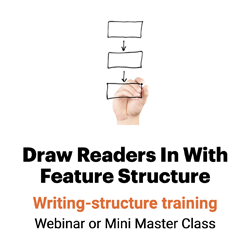Plus: 18 writing templates to try
People remember information better when stories are organized according to well-known structures. (Mandler and Johnson 1977; Kintsch, Mandel and Kozminsky in 1977; Mandler 1978; Stein 1976; and Thorndyke 1977)

The reason: People have mental frameworks — aka schemata — that they’ve built through experience and instruction. These mental frameworks provide a skeletal structure for organizing information as they read. (Anderson, 1977; Rumelhart, 1975)
“Comprehension and composition bear a reciprocal relation to each other.”
— Robert C. Calfee, Ph.D, professor of Education and Psychology at Stanford University
The more familiar the writer’s framework, the easier it is for readers to place new information into their own schematas. Otherwise, information just comes across as a list of facts, which people can only recall through rote memorization.
That’s why researchers Robert C. Calfee and R. Curley set out to create a taxonomy, or classification, of the most well-known story structures. Here’s what they learned along the way.
Common story structures
Bonnie J.F. Meyer suggests using one of these five structures for the major points in your piece:
Bonnie J.F. Meyer’s topical plans |
||
| What | How | Example |
| Antecedent and consequence | Show cause and effect, if … then. | A bylined editorial may use this approach. |
| Comparison | Present two or more opposing viewpoints. | Political speeches often use this approach. |
| Description | Develop the topic by describing its component parts, such as attributes, specifications or settings. | Newspaper articles, for instance, explain who, what, when, where, why and how. |
| Response | Organize by remark and reply, question and answer or problem and solution. | Case studies focus on the problem and solution. |
| Time-order | Relate events or ideas chronologically. | Company profiles often use this approach. |
Bonnie Armbruster, Ph.D., professor of Education at the University of Illinois at Urbana-Champaign, lists these common structures:
- Simple list: List items or ideas where the order of presentation is not significant.
- Compare/contrast: Describe similarities or differences between two or more things.
- Temporal sequence: Show the passage of time.
- Cause and effect: Organize by reason and result.
- Problem/solution: Cite the problem and the solution.
Draw a narrative line
Armbruster also offers these elements for a narrative story:
- Goals
- Actions
- Outcomes
In 1975, cognitive psychologist David Rumelhart developed this formula for a simple narrative:
- A story = a setting (It was a dark and stormy night) + 1 or more episodes
- An episode = an event (Boy meets girl) + 1 or more responses
- A response includes:
- A plan (He decided to call her).
- An action (He picked up the phone.)
- A consequence (And she came running.)
- A response includes:
All the story structures that are fit to print?
Based on their survey of story structures, Calfee and Curley developed this taxonomy.
Calfee & Curley’s taxonomy of story structures |
||
| Description | Definition | Elaborate on the meaning of a term. |
| Classification | Relate groups of objects, events or ideas according to a principle or similarity. | |
| Comparison & Contrast | Highlight similarities or differences among two or more entities. | |
| Illustration | Analogy | Compare two things or activities to help explain one of them. |
| Example | Illustrate with a sample or outstanding incidence. | |
| Sequence | Process | Show the steps toward a result. |
| Cause & effect | Show the sequence of events in a causal chain. | |
| Narration | Tell a story. | |
| Argument | Deductive | Reach a conclusion from generalities to particulars. |
| Inductive | Reach a conclusion from particulars to generalities. | |
| Persuasive | Present ideas in the most convincing manner. | |
| Evidence | Support your claim with concrete facts. | |
| Functional | Introduction | Open with a statement to introduce the position and maybe also the structure. |
| Transition | Emphasize relations among ideas or changes in theme. | |
| Conclusion | Review thematic material; tie together lines of thought. | |
| Summary | Write a brief statement of the main points. | |
| Explanation | Listing | List items or ideas where the order of presentation is not significant. |
| Instructions | Outline step-by-step how-to’s. | |
Which of these story structures can you use to make your next piece easier to read, understand and remember?
___
Sources: Robert C. Calfee, and R. Curley “Structures of prose in content areas,” In Understanding reading comprehension, ed. J. Flood. Newark, DE: International Reading Association, 1984, pp. 161-180
Bonnie J. F. Meyer, “Reading Research and the Composition Teacher: The Importance of Plans, College Composition and Communication, Vol. 33, No. 1 (February 1982), pp. 37-49
Bonnie B. Armbruster, “The problem of inconsiderate text,” in Comprehension instruction, ed. G. Duffey. New York: Longmann, 1984, pp. 202-217

Leave a Reply